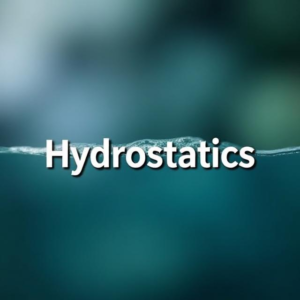hydrostatics in simple terms. Hydrostatics is the branch of physics that deals with fluids (liquids and gases) at rest. It focuses on how fluids behave when they are not moving.
1. Pascal’s Law
Pascal’s Law states that when you apply pressure to a confined fluid, the pressure is transmitted equally in all directions. This means if you push on the fluid at one point, the pressure is felt everywhere in the fluid at the same level.

Simple Example:
Imagine a syringe filled with water. If you push the plunger, the water moves and the pressure is felt at every point inside the syringe. If the syringe has multiple openings, water will flow out of them all with equal force.
In practical terms, Pascal’s Law explains how hydraulic systems work. For example, in a car’s brake system or a hydraulic lift, small force applied at one point can create a much larger force at another point.
2. Buoyancy and Archimedes’ Principle
Buoyancy is the force that allows objects to float in a fluid (like water). It’s what keeps ships afloat or makes things like balloons rise in the air.
Archimedes’ Principle explains how buoyancy works. It states:
- When an object is submerged in a fluid, it experiences an upward force equal to the weight of the fluid that is displaced by the object.
Simple Example:
- If you put a stone in water, the water level rises. This is because the stone is displacing water. The amount of water displaced is equal to the buoyant force pushing up on the stone.
- If the stone’s weight is greater than the buoyant force, it will sink. If the buoyant force is equal to or greater than the stone’s weight, the stone will float.
Archimedes’ Principle is the reason why some objects float (like a boat), even though they might seem too heavy to do so.
3. Pressure and Depth in Detail
In a fluid, pressure is the force that the fluid exerts on objects in contact with it. Pressure increases with depth because as you go deeper into a fluid, there’s more fluid above you, which means there’s more weight pressing down.
How Pressure Changes with Depth:
- At the surface of a fluid, the pressure is relatively low, just the weight of the air above.
- As you go deeper, the pressure increases because you’re experiencing the weight of more and more fluid above you.
In simpler terms:
- If you dive into the ocean, you’ll feel more pressure the deeper you go. This is why deep-sea divers need special equipment to withstand the high pressures deep underwater.
Formula for Pressure at Depth:
The pressure at a certain depth in a fluid is given by the formula:
Where:
= Pressure at depth
= Atmospheric pressure at the surface (about 101,325 Pascals at sea level)
= Density of the fluid (for water, it’s around 1000 kg/m³)
= Acceleration due to gravity (9.8 m/s²)
= Depth (how far you are under the surface)
For example, if you go 10 meters under water, the pressure will increase because there’s more water above you, pressing down on you.
Key Points:
- Pressure increases with depth in a fluid.
- Buoyancy is the upward force that lets things float.
- Pascal’s Law tells us how pressure is distributed in a confined fluid.
To summarize:
- Pascal’s Law: Pressure applied to a fluid is felt equally in all directions.
- Archimedes’ Principle: Objects float or sink based on the buoyant force (upward force) they experience.
- Pressure and Depth: The deeper you go into a fluid, the more pressure you feel because of the weight of the fluid above you.
Tags: Archimedes' Principle, atmospheric pressure, buoyancy, car brake system, confined fluid, deep-sea diving pressure, depth pressure, displaced fluid weight, floating objects, fluid behavior, fluid density, fluid displacement., fluid pressure, fluid weight, fluids at rest, force multiplication, gravity acceleration, hydraulic lift, hydraulic systems, Hydrostatics, Pascal's Law, pressure at depth, pressure distribution, pressure equalization, pressure formula, pressure increases with depth, pressure transmission, sinking and floating, static fluids, submerged objects, upward buoyant force, upward force, water pressure


